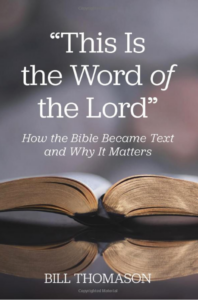Like many Christians, Bill Thomason was raised to view the Bible as the inerrant word of God derived from pristine, original manuscripts penned by the individuals actually credited with authoring them.
“I grew up in a fundamentalist Baptist church believing Moses wrote the first five books of the Bible, that David wrote the Psalms and that Isaiah was written by just one author,” said Thomason, a member of Crescent Hill Baptist Church in Louisville, Ky., and a former college religion and philosophy professor with master’s and doctorate degrees from Southern Baptist Theological Seminary.
“But as I got older, the answers I was getting in church about how the Bible came to be weren’t really satisfying and didn’t get at the complexity I was beginning to see in the Bible,” he explained.
 So, Thomason set out on an exploration of the history of the Jewish and Christian Scriptures that has culminated in his new book, “This is the Word of the Lord”: How the Bible Became Text and Why it Matters.
So, Thomason set out on an exploration of the history of the Jewish and Christian Scriptures that has culminated in his new book, “This is the Word of the Lord”: How the Bible Became Text and Why it Matters.
The project outlines the evolution of biblical texts from their beginnings as oral tradition forged in historical circumstances that shaped the content and transmission of what would become the Bible and its modern understandings.
“Fundamentalists fail to see the Bible is a historically conditioned book, which means each biblical text grows out of the historical circumstances of the time of the person who is putting that particular text together and reflects those beliefs and points of view of that time,” he said. Far from weakening or even destroying his faith, exposure to the social and cultural contexts that influenced the writing, redacting and selection of biblical content actually fostered a deeper relationship with the text and with God.
“If I hadn’t found the critical approach to the Bible that sets the Bible in its historical contexts, I would have had to say I don’t want anything to do with Christianity,” he asserted.
Thomason acknowledges the historical method presented in his book can be seen as a threat to faith by some: “I don’t want to create a crisis of faith, but I do think it’s important to be honest about what we know about how the Bible became a book.”
What is known from hundreds of years of critical biblical scholarship is that the Bible in its present form was filtered through the experiences of fallible human authors whose writings were subject to fragmentation, transmutation and reinterpretation over many centuries, Thomason believes. Failure to acknowledge and understand that process diminishes the full potential of God’s revelation in the text.
“I don’t want to create a crisis of faith, but I do think it’s important to be honest about what we know about how the Bible became a book.”
“We get ourselves in a straitjacket when we say every word is the word of God when in fact, we all pick and choose the parts of the Bible that speak to us in ways other parts of the Bible just don’t.”
The doctrine of inerrancy also creates an either-or tension between religion and science, especially around the issues of creation and evolution, he obvserves. But viewing Scripture as a living, breathing document, which studying its history inspires, provides the flexibility to avoid that perceived conflict.
“We always have to, as people of faith, take the faith we’ve inherited very seriously, but we also have to take very seriously the knowledge from sources other than the Bible, such as scientific experiment. Does that destroy the revelatory power of the Bible? For some people it may. But for me it makes the understanding of the text more real to me because this text came about because of real people struggling with real issues they we retrying to deal with.”
Thomason said he wrote the book for clergy, laypeople and for use in introductory Bible courses.
The book’s numerous endorsements indicate Thomason accomplished that goal.
“Giving readers a fresh perspective, it shows that the Bible has its own DNA, imprinted in it from the history that lies behind it and to which its writers spoke. Thomason gives us an engaging tour of the 1,000- to 1,200-year period in which the Scriptures were written and deepens our appreciation for the Bible and its writers in the process,” said R. Allen Culpepper, dean and professor of New Testament emeritus at Mercer University’s McAfee School of Theology.
Doug Weaver, professor of Baptist studies at Baylor University, said Thomason’s book “avoids the traps of secular skepticism of biblical authority or the naiveté of fundamentalists. Thomason affirms a middle ground, suggesting that knowledge of the ancient world and how the biblical writings developed into the Bible will help us use the Bible authoritatively today for Christian living.”
Former Judson Press publisher Kristy Arnesen said Thomason “has provided a unique resource for those of us who revere the Bible but know it was written by fallible humans. By tracing the history of how the Bible came to be written and why it rightly holds a place of authority and honor, Thomason presents a road map for understanding the context of biblical times and seeing the wisdom in the pages of what is a sacred text for millions of people around the world.”
Related articles:
How the Chicago Statement on Biblical Inerrancy became a litmus test | Analysis by Rick Pidcock
Why biblical inerrancy should be a litmus test | Analysis by David Bumgardner
Slavery, race and biblical authority: Before we claim the Bible is ‘inerrant,’ let’s confess that we aren’t | Opinion by Bill Leonard


